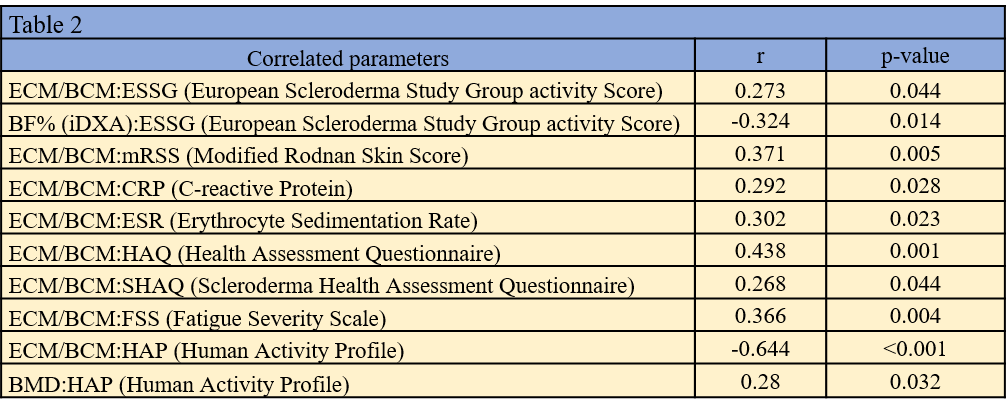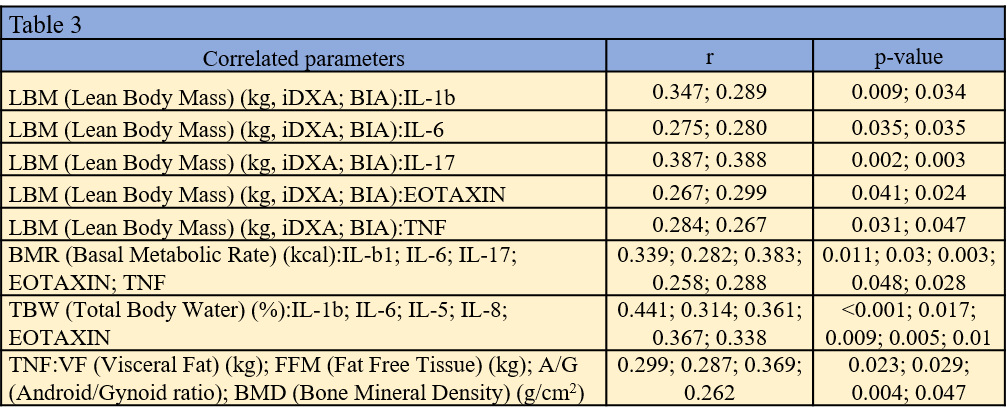Session Information
Session Type: ACR Poster Session B
Session Time: 9:00AM-11:00AM
Background/Purpose: Fibrosis of the skin and visceral organs, especially digestive tract, and musculoskeletal involvement in systemic sclerosis (SSc) can have a negative impact on body composition and physical activity. The aim was to assess body composition and physical activity of SSc patients and healthy controls (HC) and the association with selected inflammatory cytokines in SSc.
Methods: 59 SSc patients (50 females; mean age 52.5; disease duration 6.7 years; lcSSc:34/dcSSc:25) and 59 age-/sex-matched HC (50 females, mean age 52.5) without rheumatic or tumour diseases were included. SSc patients fulfilled ACR/EULAR 2013 criteria. We assessed body composition (densitometry: iDXA Lunar, bioelectric impedance: BIA-2000-M), physical activity (Human Activity Profile, HAP questionnaire), disease activity (ESSG activity index) and serum levels of 27 cytokines (commercial multiplex ELISA kit, Bio-Rad Laboratories). Data are presented as mean±SD.
Results: Compared to HC, SSc patients had significantly lower body mass index (BMI), body fat % (BF%) and visceral fat weight (VF), and also significantly decreased lean body mass (LBM), and bone mineral density (BMD). Compared to HC, SSc patients had increased extracellular mass/body cell mass (ECM/BCM) ratio, reflecting deteriorated nutritional status and worse muscle predispositions for physical activity (Table 1). Increased ECM/BCM in SSc positively correlated with disease activity (ESSG), skin score (mRSS) and inflammation (CRP, ESR), and was associated with worse quality of life (HAQ, SHAQ), fatigue (FSS), and decreased physical activity (HAP). ESSG negatively correlated with BF%. HAP positively correlated with BMD (Table 2). Increased serum levels of several inflammatory cytokines were associated with alterations of body composition (Table 3).
Conclusion: Compared to healthy age-/sex-matched individuals we found significant negative changes in body composition of our SSc patients, which are associated with the disease activity and physical activity, and could reflect their nutritional status, and gastrointestinal and musculoskeletal involvement. Serum levels of certain inflammatory cytokines were associated with alterations of body composition in SSc patients. Acknowledgement: AZV-16-33574A, MHCR 023728 and GAUK 312218.
To cite this abstract in AMA style:
Oreska S, Spiritovic M, Cesak P, Cesak M, Storkanova H, Smucrova H, Hermankova B, Sumova B, Ruzickova O, Mann HF, Pavelka K, Šenolt L, Vencovsky J, Becvar R, Tomcik M. Alterations of Body Composition in Patients with Systemic Scleroderma Are Associated with Disease Activity, Physical Activity and Serum Levels of Inflammatory Cytokines [abstract]. Arthritis Rheumatol. 2018; 70 (suppl 9). https://acrabstracts.org/abstract/alterations-of-body-composition-in-patients-with-systemic-scleroderma-are-associated-with-disease-activity-physical-activity-and-serum-levels-of-inflammatory-cytokines/. Accessed .« Back to 2018 ACR/ARHP Annual Meeting
ACR Meeting Abstracts - https://acrabstracts.org/abstract/alterations-of-body-composition-in-patients-with-systemic-scleroderma-are-associated-with-disease-activity-physical-activity-and-serum-levels-of-inflammatory-cytokines/



